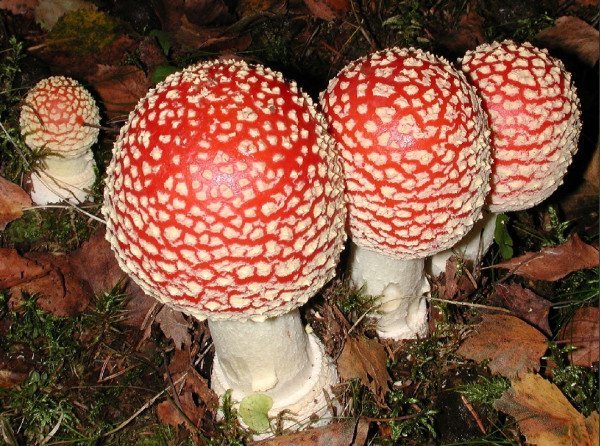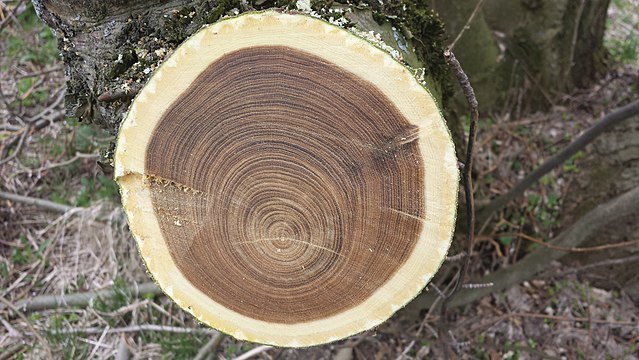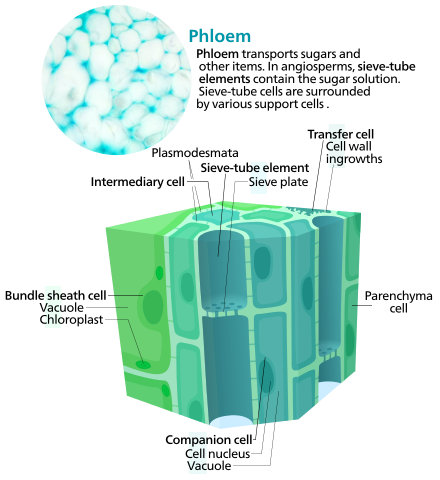Greetings to the entire HiveSTEM community.
Thanks for all the supports and motivations. It’s great to be back on Hive. In
my last post, I explained vividly on how plants work talking about the life of plants.
In this post, I will explain more on the topic starting with what mycorrhizas
are and the characteristics of xylem and phloem.
So, what are MYCORRHIZAS?
Over three-quarters of known plant species, and virtually all tree species, have a partner in the soil; a fungus. This association is known as a mycorrhiza and is an example of a mutualistic symbiosis; an arrangement in which both partners benefit. The fungus receives sugars from photosynthesis and possibly some B-group vitamins, while the plant benefits from greatly increased absorption of mineral ions and water.
Young plants become infected with the fungus at an early age and from then on root hair production either stops or is greatly reduced. However, the fungal threads form a network throughout the surrounding soil, providing a much larger surface area than could be achieved with the root hairs alone.

Many conspicuous fungi such as the fly agaric (upper left) form ectomycorrhiza (upper right) with tree rootlets. Arbuscular mycorrhiza (lower left) are very common in plants, including crop species such as wheat (lower right). http://www.biomedcentral.com/1471-2105/6/178, CC BY 2.5
There are two types of mycorrhiza. Ectotrophic mycorrhizas surround the root and penetrate the air spaces in between the cells of the cortex, but they do not penetrate the actual cells. This type is common in forest trees such as oak and beech. In contrast, the threads of endotrophic mycorrhizas penetrate the walls of the cortical cells. Endotrophic mycorrhizas are the commoner of the two types, being found in the roots of most plant species.
Mycorrhizas have great significance in plant growth and therefore in agriculture, though our knowledge of their biology is still very limited.
XYLEM AND THE TRANSPIRATION STREAM
Transpiration involves vast amounts of water passing through plants and out into the atmosphere. In one investigation in the USA, a 15 m maple tree was estimated to have some 177 000 leaves with a total surface area of 675 square metres. On a summer day, the tree lost 220 litres of water per hour to the atmosphere through the leaves. The roots, of course, needed to provide 290 per hour to prevent wilting. To understand how all this water gets to the tops of tall trees we need to look at xylem tissue.
XYLEM TISSUE – A RIVER RUNS THROUGH IT
Xylem tissue is a specialized conducting tissue. Ironically, it function only when it is dead. Xylem tissue consists of dead, elongated cells called vessel elements, connected end to end to form a network of conducting tubes. The development of xylem vessels is shown in the diagram. A second type of xylem vessel – tracheids – also form part of the conducting tissue. In evolutionary terns, tracheids are older and less specialised. They differ from vessel elements by being narrower and have having numerous pits (holes) in their side walls that allow sideways movement of fluid. Remember that transpiration is the loss of water from the upper surfaces of a plant. Most water is lost through the stomata on the underside of leaves. The transpiration stream is the gradual water flow through the plant, starting from the roots to the leaves. The xylem tissue is mainly responsible for this flow.

Xylem (blue) transports water and minerals from the roots upwards. Nefronus, CC BY-SA 4.0
So how does water get all the way to the top of trees? Is it pulled or is it pushed? The simple answer is that it’s pulled, but experiments have shown that three forces combine to draw water up the plant in the xylem vessels.
- Capillarity: Xylem vessels are very thin: 20 μm to 400 μm. When a cut stem is placed in water, fluid is drawn up to about 1 metre – a significant help in smaller plants but nothing like enough to get water to the top of a tall tree.
- Root pressure: If the roots created a significant force, fluid would spurt out if the stem was cut. This is not the case. But root pressure can be demonstrated and is a contributory factor. Root pressure is created when the cells of the endodermis actively secrete mineral ions into the xylem. This creates a water potential gradient and water follows by osmosis, creating root pressure. This is specially important in very young plants, whose leaves have not yet fully developed.
- Cohesion-tension: Even when the stem cut, ruling out the contribution from the two forces above, water still reaches the top. This third force therefore needs looking at in more detail …
The cohesion-tension hypothesis
When you suck up a drink with a straw, you create a negative pressure with your mouth and a continuous stream of fluid is pulled up through the straw. The fluid in the straw is under negative pressure, so if you pierce the straw with a needle, air will be sucked in rather then fluid spurting out. Once air is inside the straw, the column is broken and the straw doesn’t work. It’s much the same with xylem vessels. There is usually a negative pressure inside the xylem vessels of the stem, because water is pulled up the plant from the leaves. This mechanism of transpiration is known as the cohesion-tension hypothesis.
Water molecules are polar and therefore cohesive (‘sticky’) – they cling to each other with such force that an enclosed column of water has great tensile strength – it will not break or separate into droplets except under huge tension. The cohesion-tension hypothesis states that as water evaporates from the leaves, it creates a negative pressure in the xylem that pulls a continuous column water up from the roots. Water molecules form a continuous column from the surface of the mesophyll cells and down the xylem. Interestingly, as the pull on the column of water increases, the xylem vessels get narrower. The circumference of trees shows a measurable decrease during the day when the plant is actively transpiring.
In plant cells, the primary cell wall is a relatively thin layer of cellulose in xylem cells, the secondary cell wall is a complex structure made from two polymers – cellulose and lignin, with some protein. The cellulose forms strong fibres, while the lignin forms an interlocking network in between the cellulose – like reinforced concrete. The lignin also makes the xylem vessels impermeable to water – obviously a key feature in a conducting tissue.
Secondary cell walls can be laid down in a variety of patterns; most commonly annular rings (hoops) or spirals. The significance of this pattern is that it prevents collapse inwards, while allowing elongation. In older xylem vessels, the pattern is more elaborate, running in all directions, and prevents any further elongation.
THE LEAF, STOMATA AND WATER LOSS
In most plants, the leaf is an organ of photosynthesis. In order to photosynthesize effectively, a leaf must also be an organ of gas exchange. Consequently, it has a large surface area and must be permeable to gases. To aid gas exchange, the leaves have many holes – stomata – that allow carbon dioxide to diffuse efficiently to the photosynthesising cells, and allow the waste oxygen to leave. The loosely packed mesophyll cells, with their wet cell walls, inevitably lose a lot of water to the environment through the stomata. To minimize water loss, the upper epidermis of most plant species secretes a thin layer of wax: the cuticle.
Stomata are pores that in most species, but not all, are more numerous on the underside of the leaf than on the top. Each pore, or stoma, is surrounded by two specialized epidermal cells, the guard cells, that can alter their shape to open or close the hole. The guard cells are banana shaped, attached at the top and bottom but not along their length. The cell wall of guard cells has radially arranged microfibrils, so when these cells absorb water, they cannot swell but can elongate and bend. As they do so, they open the stoma.
The basic mechanism of stomatal opening is in four stages:
- When it gets light, photosynthesis begins, producing ATP.
- ATP powers an active transport mechanism in the guard cell membranes – potassium ions are pumped into the guard cells.
- This lowers the water potential of the cells, so water moves in by osmosis.
- The turgidity of the guard cells increases, so the cells bend, opening the stoma.
Xylem, wood and tree growth
In order for plants to win the race for that all-important light, they had to develop taller and stronger stems. As a result xylem vessels took on a second function – that of support. Xylem vessels contribute greatly to the familiar substance we call wood – a tissue that develops from a process known as secondary growth. Put simply, the cambium cells divide year after year to produce a new layer of xylem vessels outside the old ones. Thus every year the trunk and branches of trees and shrubs get thicker as the disused conducting tissue accumulates inside.
It is widely known that you can tell the age of a tree by counting its annual rings. These are a result of growth at different rates during the different seasons. In the spring, when water is plentiful, the new vessel elements and tracheids tend to be large in diameter but with thin walls. As water becomes scarcer during the summer, the vessels are narrower with thicker walls. Thus summer wood is denser and darker than spring wood. The annual rings are much less defined in the wet areas of tropics, i.e. rainforests, where water supply is relatively constant.
Interestingly, trunks and branches become thicker in response to stress on the tree. Following an observation that trees grown indoors were more slender than their outdoor counterparts, it was found that the stresses and strains caused by wind cause the tree to become more sturdy. These conditions can be reproduced indoors by shaking a tree or even beating the trunk with a mallet.
Tree rings and climate change
The science of dendrochronology – studying tree rings – is very useful for looking at how the Earth’s climate has changed over time. Analysing the overall pattern of tree rings from fossilised tree trunks can provide a lot of information about how the temperature has fluctuated in the past.

Freshly cross cut laburnum with visible heart-wood. Per Grunnet CC BY-SA 4.0
In this section through a Laburnum tree trunk, the active xylem (known as the sapwood) is the outermost ring, just under the bark, while the phloem forms the inside of the bark. The xylem from previous years is now dead and just has a supporting role. How old do you think this tree is?
In the flow of water through a leaf. Wind Movements take away humid air and replace it with drier air, thus maintaining a water potential gradient:
- Stage 1: Mass flow in air
Wind movements (mass flow) take air, fully saturated with water vapour, away from the leaf surface. The air replacing it contains less water vapour and this maintains a concentration gradient for water vapour leaving the air spaces of a leaf.
- Stage 2: Diffusion of water in still air
Water vapour diffuses down a concentration gradient through the leaf air spaces, through open stomata, and through the boundary layer of still air on the outside of the leaf
- Stage 3: Diffusion of water through cells
Water loss from the surface of cells lowers the water potential inside the cells. Water at a higher potential diffuses from the nearest xylem vessel through leaf cells to replace lost water.
- Stage 4: Mass flow of water in xylem vessels
Pressure in xylem vessels is lowered as water leaves them. Water moves up the xylem vessel from the roots, where the pressure is higher.
What affects the rate of transpiration?
The factors affecting the rate of transpiration are generally those that increase evaporation. The commonest factors are:
Temperature: The higher the temperature, the faster water molecules will evaporate.
Humidity (the amount of water vapour in the air): For water to evaporate, there must be a water potential gradient between the air in the leaf and the atmosphere. Dry air has a very low water potential. The more humid it is, the higher the water potential of the air, and the smaller the water potential gradient. Therefore, transpiration is slower in humid conditions.
Air movement (i.e. wind speed): Wind will blow away the small pocket of humid air that develop when the air is still. Humid air is replaced by drier air, so the water potential gradient is maintained.
Also, light affects transpiration, but more indirectly than the above three factors. In general, light causes stomata to open, greatly increasing the passage of water vapour out of the plant.
TRANSLOCATION AND PHLOEM
The leaves make most of the organic molecules synthesised in a plant, but there are many other areas of the plant that need this ‘food’-the roots, the flowers, the seeds and fruits, etc. In fact, all the non-green plants. In this section, I will look at the way in which the products of photosynthesis are moved around the plant.
BASIC DEFINITIONS
Source: The parts of a plant that make or store food. The commonest sources are the leaves, but other parts that contain chlorophyll, e.g the stem, can be a source, as can arcas of stored food such as tubers.
Sink. The parts of the plant that need food- notably the roots, flowers, fruits and growing points (meristems).
Translocation. The movement of materials, such as sucrose, from sources to sinks via the phloem tissue.
PHLOEM TISSUE – CHAINED TO THE SINK
Phloem tissue is conducting tissue and is similar to xylem in several ways; It is a network of elongated, tubular cells that forms a transport system throughout the plant – xylem and phloem usually occur together. However, phloem tissue is different from xylem in several important ways:
- Its cells are alive – remember that xylem only works when it is dead.
- It moves products of photosynthesis, notably sucrose and amino acids, while xylem just moves water and dissolved minerals.
- Movement in phloem occurs both up and down the stem. Movement in xylem is in one direction only – from the roots to the leaves.
- Fluid in phloem is usually under positive pressure – sap will ooze out if phloem is pierced. Fluid in xylem is usually under negative pressure so air will enter if vessels are pierced.
- Phloem sieve tubes, unlike xylem vessels, do not have lignified walls and are permeable to water and solutes.

Cross section of some phloem cells. Kelvinsong, CC BY-SA 3.0
Phloem tissue is made up from two different types of cell: sieve elements and companion cells. Sieve elements are joined end to end by a sieve plate that allows movement of substances through in a continuous stream. Sieve elements have some living cytoplasm around the outside of the cell, but notably there is no nucleus or vacuole. The companion cell, in contrast, does have a nucleus, is smaller and is metabolically very active. Experiments have shown that the two types of cell are very closely linked. They are products of the same cell division and share many cytoplasmic connections. It seems that the companion cell maintains the sieve element once it has fully differentiated and lost its nucleus. The association is so close that if the sieve element dies, so does the companion cell. The relationship between the two cells is poorly understood, but it seems that the companion cell provides the sieve plate with mRNA and some essential proteins.
In my next post, i will like to discuss on the mechanism of translocation in phloem and living in extremes.
I will pause here for now, thanks for reading.
REFERENCES
https://en.wikipedia.org/wiki/Transpiration
https://nph.onlinelibrary.wiley.com/doi/full/10.1111/nph.15899
https://socratic.org/questions/how-do-stomata-help-conserve-water
https://en.wikipedia.org/wiki/Xylem
https://science.jrank.org/pages/7409/Wood.html
https://www.frontiersin.org/articles/10.3389/fpls.2016.00734/full
https://climatekids.nasa.gov/tree-rings/
https://en.wikipedia.org/wiki/Dendroclimatology
http://www.biologyreference.com/Ta-Va/Translocation.html
https://www.toppr.com/guides/biology/transport-in-plants/phloem-transport/
https://www.bbc.co.uk/bitesize/guides/zps82hv/revision/1
https://biologydictionary.net/phloem/
https://en.wikipedia.org/wiki/Phloem
https://www.britannica.com/science/phloem
https://docplayer.net/20843905-As-biology-revision-notes-unit-3-physiology-and-transport.html
https://untamedscience.com/biology/ecology/mycorrhizae/
https://en.wikipedia.org/wiki/Mycorrhiza
http://archive.bio.ed.ac.uk/jdeacon/microbes/mycorrh.htm
https://www.ncbi.nlm.nih.gov/pubmed/12237379
https://www.britannica.com/science/xylem
http://bio1520.biology.gatech.edu/nutrition-transport-and-homeostasis/plant-transport-processes-i/
https://www.britannica.com/science/cohesion-hypothesis
https://medical-dictionary.thefreedictionary.com/cohesion-tension+hypothesis
If you appreciate the work we are doing, then consider supporting our witness @stem.witness. Additional witness support to the curie witness would be appreciated as well.
For additional information please join us on the SteemSTEM discord and to get to know the rest of the community!
Thanks for having used the stem.openhive.network app. This granted you a stronger support from SteemSTEM. Note that including @steemstem in the list of beneficiaries of this post could have yielded an even more important support.